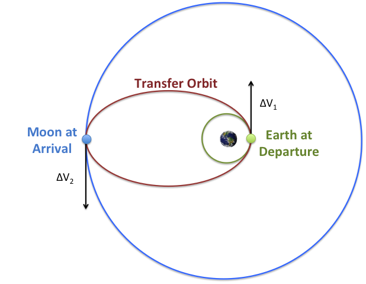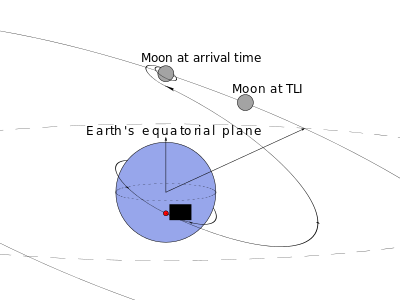This is just to add some more details to jdunlop's answer.
I have done something like that quite a few times in Kerbal Space Program. Not because I wanted to bombard the game's equivalent to our Moon, but because I am cheap. Some missions require you to gather data from a certain altitude from the Mün's surface, but don't say anything about soft landing or returning, so a dumb impactor is the cheapest way to go.
If you want to go from a planet to a satellite of that planet, Hohmann is your homie. This is what a Hohmann transfer to the Moon looks like:

As you can see, a single burn is required to set you towards the Moon. A second burn is required if you want to orbit the Moon after that, but that would be no fun we don't want that.
Could we add enough speed in one burn to reach the Moon?
Yes, we can! The russians did so for the first time in 1959, followed by US's Apollo missions:
The first space probe to successfully perform TLI [Trans-lunar injection] was the Soviet Union's Luna 1 on January 2, 1959. The first human-crewed mission to successfully perform this procedure, and thus becoming the first humans to leave the Earth's influence, was Apollo 8 on December 21, 1968.
For the Apollo lunar missions, the restartable J-2 engine in the third (S-IVB) stage of the Saturn V rocket performed TLI. This particular TLI burn lasted approximately 350 seconds(...)
So, with technology that is largely outdated today, we can accelerate humans from low Earth orbit to a Moon-impacting trajectory in less than six minutes. I have a feeling that by the time we colonize the Moon we should be able to accelerate a bomb towards the Moon in much less time.
Could we do it without being seen from the Moon?
Sure! Look at this essay from NASA, about the Apollo missions' launch windows (all emphasis are mine):
In order to accomplish this 'rendezvous' with a minimum expenditure of propellant, the injection (TLI) must occur very close to the extension of the earth-moon line at the time of the spacecrafts lunar arrival. This is termed the negative of the unit vector of the moons position (the position on the opposite side of the earth from the sub-lunar point), which is called the moons antipode. The optimum trajectory is very similar to a Hohmann transfer.
This minimum energy transfer trajectory would have placed the earth parking orbit perigee at the moons antipode if the moons mass did not perturb the trans lunar trajectory. However the moon does perturb the spacecrafts trans lunar trajectory, as shown in figure 5 above, and therefore the earth parking orbit perigee must lead the moons antipode by approximately 8 degrees to compensate. The apogee altitude of the osculating conic trans lunar trajectory was determined by the trans lunar flight time which defined the trajectory energy requirements at trans lunar injection (TLI).
To inject the spacecraft to the moon in the most efficient manner, an impulsive velocity (acceleration) would be added along the orbital velocity vector (direction), giving an injection at the perigee of the trans lunar conic. Since an impulsive (instant) addition of velocity is not possible, a finite burn time is required, and the actual injection position is on the order of 20° ahead on the antipode. The thrust from the S-IVB is directed approximately along the velocity vector, and as the velocity increases above orbital, the altitude and flight-path angle increase. For the Apollo lunar orbit rendezvous flight mode, by the time sufficient energy has been gained, the altitude has increased by 60 to 75 n. miles above that of the earth parking orbit and a positive flight-path angle of 6° had been attained. Since the conic trajectory is very nearly parabolic (eccentricity 0.97) the true anomaly is approximately equal to twice the flight-path angle, so perigee is approximately 12° to 14° behind the burn cut-off position. The TLI burn arc itself is 25°, so that ignition always occurs within a few degrees of the moons antipode.
Again, a rocket with current or better technology, and more specifically not carrying squishy humans would easily outperform the J-2 and Saturn V rockets used in the late 60's. All in all, the TLI would look like this...

... But the payload would not need to perform a full orbit around the Earth before the trans-lunar injection burn.
Can we make the payload stealthy?
Of course we can! First things first, drop the requirement that it has to be a nuke, that is wasteful and inelegant. You don't need a nuke to do some huge damage.
With current or near future technology, it would be quite feasible to send them lunarians:
- A 100 meters wide lump of iron;
- Hitting the ground at 45°;
- And touching ground at 5 kilometers per second.
You may be thinking that a hundred meters is too much. It is for today, but not for a civilization that has built a self-sufficient colony on the moon.
One advantage of iron is that it will cool off in minutes after the TLI burn. If you need it to cool in less time, you can add a heat sink as part of the TLI stage, and you can make that stage turn around and return to Earth a minute after decoupling from the payload.
With no burns visible from the Moon, no radioactive material in it, and zero emissions, they would not see it until it is too close. As for how much damage that would do, I have used a simulator to drive my point:
http://simulator.down2earth.eu/results.html?lang=en&dist=&planet=Moon&dist=0&diam=100&traj=45&velo=5&pjd=4&tjd=i&wlvl=0
Here is what the impact profile would look like. The Empire State building would fit inside the crater:

I think the debris flying out of that would cause multiple smaller cratters to appear surrounding the main one. And since this is cheap and simple, you can just rinse and repeat. Have fun!
Could they really not see it coming?
We can barely predict where a falling space station will touch down, and it is not unusual for us to learn about a passing asteroid after it has passed by us.
Supposing they do see it coming, what can they do?
Lunarians' only hope is deflection. If you blow the payload up, the pieces will still have momentum going towards the moon, and the damage will be practically the same - only more spread throughout the land. Add to that, the Earth can simply keep spamming those things at them. At some point surrendering becomes cheaper than maintaining a permeable defense system just to fight an uphill battle.






